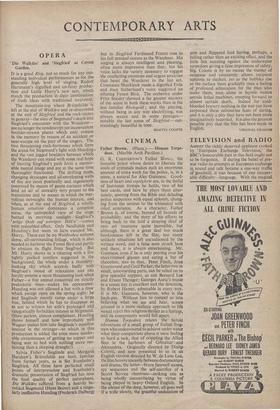CONTEMPORARY ARTS
OPERA
'Die Walkilre' and 'Siegfried' at Covent Garden.
IT is a good Ring, not so much for any out- standing individual performances as for the generally high level of singing, Rudolf Hartmann's dignified and un-fussy produc- tion and Leslie Hurry's new sets, which match the production in their combination of fresh ideas with traditional treatment.
The mountain-top where Briinnhilde is left at the end of Walkiire and re-discovered at the end of Siegfried and the rock-scenes in general—the sites of Siegmund's death and Siegfried's encounter with the Wanderer— are no longer the nondescript yet inconvenient boulder-strewn places Which only remain in the memory by reason of an accident or near-escape on the part of the singers. The two threatening rock-fortresses which form the arena for Siegmund's fight with Hunding. and the vast jagged boulders between which the Wanderer can stand with some real hope of barring Siegfried's path form a memor- able mental image and are at the same time thoroughly functional. The drifting mists, changing skyscapes and all-enveloping walls of fire are most poetically and ingeniously contrived by means of gauze curtains which lend an air of unreality very proper to the transitions and to scenes in which the mar- vellous outweighs the human interest, and when, as at the end of Siegfried, a wholly human emotion dominates a complete scene, the unimpeded view of the stage bathed in morning sunlight--Siegfried's selige Oede auf sonnigen Heih'n'— comes with redoubled effect. Only Neidhohle and Hunding's hut seem to have escaped Mr. Hurry. There can be no Waldweben without dense, all-surrounding foliage, which is also needed to harbour the Forest Bird and partly to obscure its flight from Siegfried. But Mr. Hurry shows us a clearing with a few tightly packed conifers suggested in the background, the whole under a thundery- looking sky which accords badly with Siegfried's mood of relaxation and can hardly assume a more threatening look when Fafner—a fine animal conceived on strictly prehistoric lines—makes , his appearance. Hunding was not allowed a hut with a door Which swings open on the spring night: he and Sieglinde merely camp under a large tree, behind which he has to disappear so as not to witness his wife's prolonged and categorically forbidden interest in Siegmund. (How patient, almost complaisant, Hunding shows himself and how improbably well Wagner makes him take Sieglinde's manifest interest in the stranger—to which in this Production is added the even more intoler- able circumstance of getting no supper and being sent to bed with nothing more sus- taining than a sleeping draught!) Sylvia Fisher's Sieglinde and Margaret Harshavv's 131 Onnhilde are both familiar from former years, as is Set Svanhohn's Siegfried. All three have perfected small Points of interpretation and Svanholm's dramatic presentation of Siegfried has now the final quality of perfect naturalness. Die Walklire suffered from a heavily be- colded Siegmund (Hans Beirer) and a singu- larly ineffective Hunding (Frederick Dalberg) but in Siegfried Ferdinand Frantz rose to his full musical stature as the Wanderer. His singing is always intelligent and pleasing, often more impressive than that; but his voice lacks the variety necessary to suggest the conflicting emotions and urgent anxieties that beset the Wanderer in the last act. Constance Shacklock made a dignified Erda and Joan Sutherland's voice suggested an alluring Forest Bird. The orchestra under Fritz Stiedry 'showed a far greater mastery of the score in both these works than in the less familiar Rheingold ; and the playing, without being in any way electrifying, was always secure and in some passages— notably the last scene of Siegfried— out- standingly beautiful in tone.
MARTIN COOPER


































 Previous page
Previous page